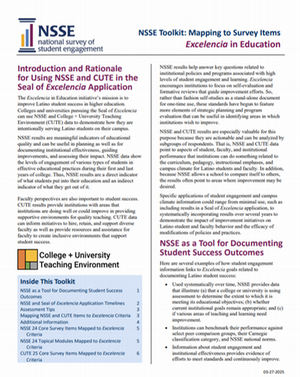1. Student engagement results provided by NSSE are one direct indicator of what students put into their education and an indirect indicator of what they get out of it.
2. NSSE items can be useful in analyzing resources and appraising the effectiveness of the institution in fulfilling its mission, including aspects that reflect special mission (HSI, HBCU, Women’s College, etc.) Measures included in NSSE’s educational gains items ask about the extent to which students’ experiences at the institution have contributed to their knowledge, skills, and personal development in important dimensions for student learning and success. Measurement of these experiences could be used to demonstrate the achievement of the institution’s mission and goals.
3. NSSE and CUTE data are actionable in that they point to aspects of student and performance institutions can address related to the curriculum, pedagogy, instructional emphases, and campus climate. In addition, because NSSE benchmarks allow a school to compare itself to others, the results often point to areas where improvement may be desired.
4. Both the NSSE and CUTE surveys ask a variety of questions (social demographics, student characteristics, faculty employment information, etc.) that can be used to disaggregate data. Not only do such questions allow for institutions to showcase the programs and practices that support Latino students and faculty, but they allow for the examination of engagement and climate within subpopulations of the Latino community.
5. The CUTE survey measures faculty experiences and supports in creating inclusive learning environments that support diverse students. Combined, NSSE and CUTE results can help identify areas of strength as well as aspects of the undergraduate experience that may warrant attention and stimulate discussions on improving teaching, learning, and the quality of students’ educational experience.
6. Share NSSE and CUTE results with appropriate campus community members to help make the most of findings. For example, distribute NSSE results on the experience of Latino students to academic support services and Latino cultural centers. Data regarding the degree to which Latino students report the institution helps them cope with nonacademic responsibilities and succeed academically and their satisfaction with advising can be used to demonstrate adequate provision of services to meet students’ learning and personal development needs.
7. NSSE and CUTE results can help assess the degree to which the institution encourages contact among students from different economic, social, and racial or ethnic backgrounds and the extent to which students report that their experiences at the institution have contributed to their knowledge, skills, and personal development in understanding people of other racial and ethnic backgrounds. Results also can demonstrate institutional effectiveness in responding to the increasing diversity in society through educational and co-curricular programs.


